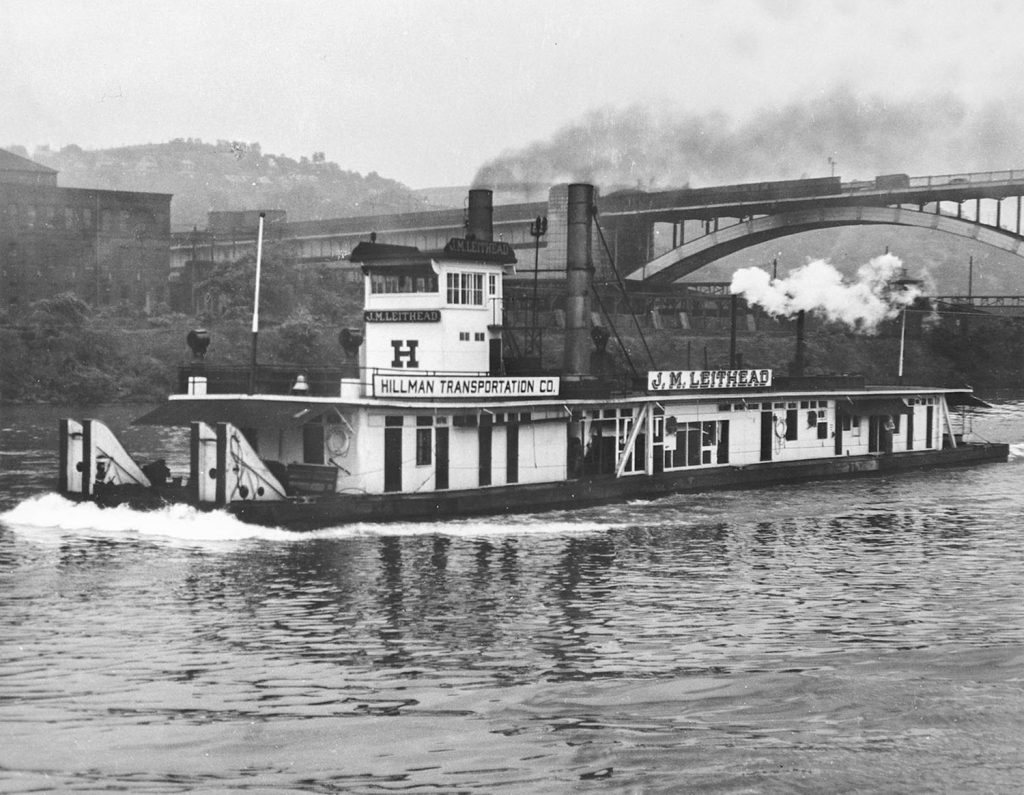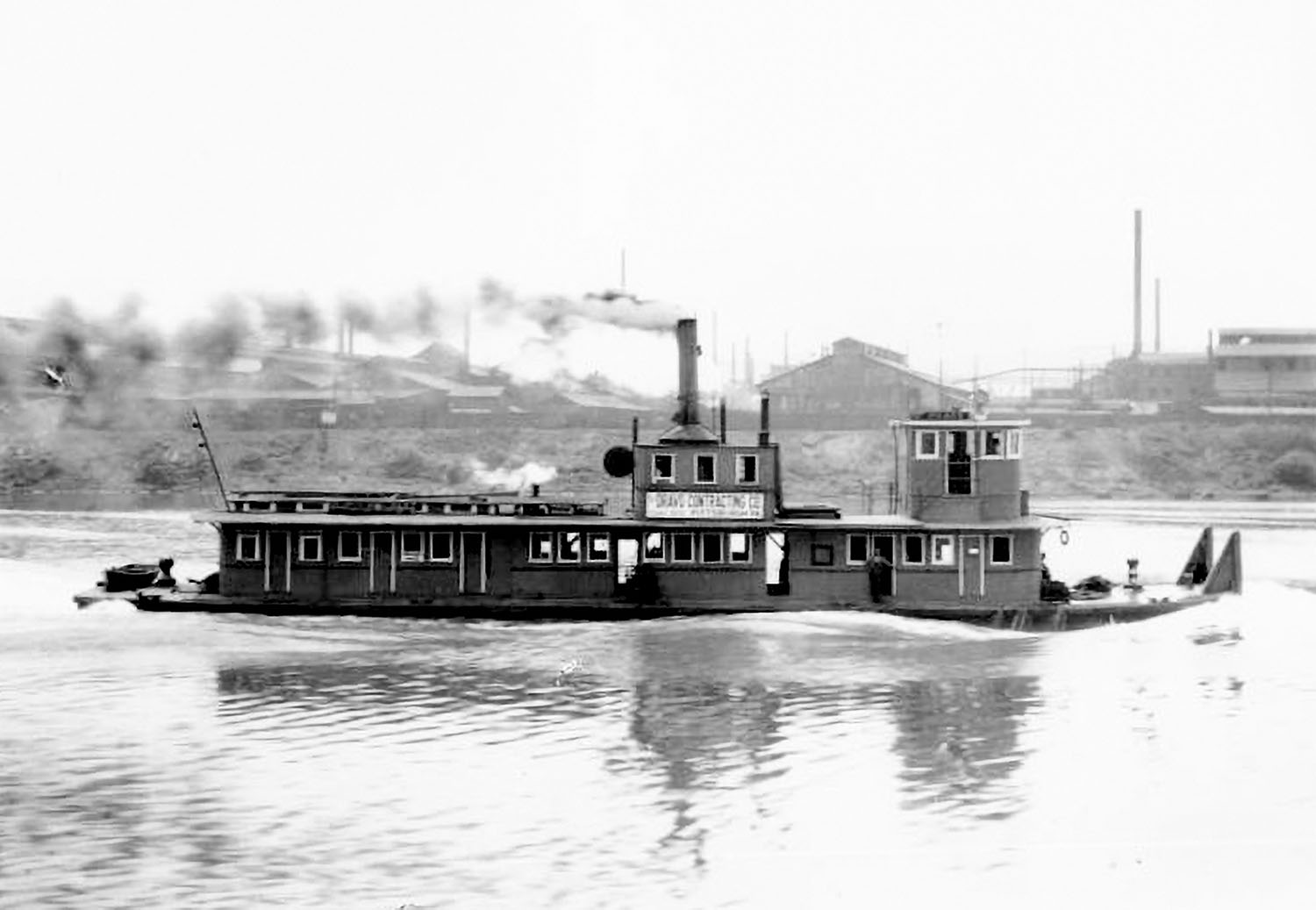It can only be supposed that the attention generated by the success of the early Ward-built, prop-driven towboats commanded a lot of attention throughout the inland rivers. The Dravo Contracting Company was fairly new to vessel construction and had primarily built sand dredges and barges when it began design work on a tunnel-stern, prop towboat in 1915. The company began building the boat in 1916, and Way’s Steam Towboat Directory says that the trial trip was made on January 25, 1917.
A Company of Uncommon Enterprise, a history of Dravo published by the company in 1974, makes but bare mention of the boat. The vessel appears to be the first towboat built by Dravo. The vessel was of steel construction with a hull 108 by 22 feet. It had twin screws, but there is no mention anywhere of the particulars of the steam engines installed. It had upright boilers and but a single cabin with pilothouse located forward atop that. Twin smokestacks rose out of a structure behind the pilothouse, and these stacks were able to fold back to allow clearance for the low bridges in the Pittsburgh pools.
The new boat was christened Peace; it would be the first of three boats operated by Dravo affiliates to possess that name. It was utilized in both the Keystone Sand division and the contracting division of the company. When the next boat was built by Dravo for the Keystone Sand division in 1919, it was a steam sternwheeler named Victory (detailed in the August 22, 2022, issue of The Waterways Journal). Dravo would not build another prop towboat until the large steam-prop Ohio and Tennessee for the Mississippi Valley Barge Line in 1930. They would not again build a prop boat for their own use until the single-screw, diesel-powered Pioneer in 1934.
Way’s indicates that the Peace “finally was dismantled at the Neville Island yard,” but does not give a date. Dravo built the “ultra-modern” diesel twin-screw Peace for Dravo affiliate Union Barge Line in 1934 (WJ, October 3, 2022), so the original boat of that name was probably taken out of service about the same time. The first Peace was last shown in the 1935 List of Merchant Vessels and listed as “Abandoned.”
Carnegie Steel
Another Pittsburgh-area firm that became curious about tunnel stern, prop towboats was Carnegie Steel. In 1918, Carnegie had the Charles Ward Engineering Company, Charleston, W.Va., build a twin-prop steam towboat for Monongahela River service. Named Clairton, the boat had a steel hull measuring 157 by 26 feet. It was fitted with triple-expansion, condensing engines, 12’s, 36’s, 72’s (no stroke given) and rated at 1,000 hp. There were four return-flue boilers that were coal-fired. Like Dravo’s Peace, it was a single-deck vessel with pilothouse forward and folding stacks aft of that. Photos indicate that coal storage for the furnaces was located behind the pilothouse.
Way’s states that the new Clairton made its initial arrival at Pittsburgh on September 9, 1918, and had a somewhat less than auspicious start when it sank the night of October 14 at the Pike Mine near Brownsville, Pa. Within a year it was renamed Kanawha when a new steam sternwheel Clairton entered service. Carnegie, which became Carnegie Illinois Steel and then U.S. Steel, would not build another propeller-driven line-haul towboat until Dravo built the 1,066 hp. twin-screw diesel B.F. Fairless for them in 1951.
In May 1926, the Kanawha was sold to the Monessen Coal & Coke Company, which named it Alicia. In September 1928, while locking at Mon River Lock 5, a marriage was performed aboard by a Brownsville, Pa., justice of the peace for Mr. and Mrs. Robert Pastor. Pastor was a crew member of the Alicia. The boat went through a rebuilding program in 1930 and was tied up then until late 1933. In June 1936, it was sold to Hillman Coal & Coke Company and renamed Henry A. Roemer.

Hillman Transportation Company, Pittsburgh, acquired the boat in August 1944, and the oft changed nameboards were changed one last time to reflect its new name of J.M. Leithead. Capt. Morris Seifried was master during this ownership. In 1950 it was finally sold to Charles Zubik & Sons, Pittsburgh. The 1951 edition of the Inland River Record says that it was being converted to diesel with the installation of Winton engines totaling 1,200 hp. It is doubtful that this conversion ever took place as the 1952 IRR listed the Leithead in the Off The Record section, stating that it had been dismantled at Pittsburgh in 1951.
Caption for top photo: Dravo steam prop towboat Peace. (David Smith collection)



